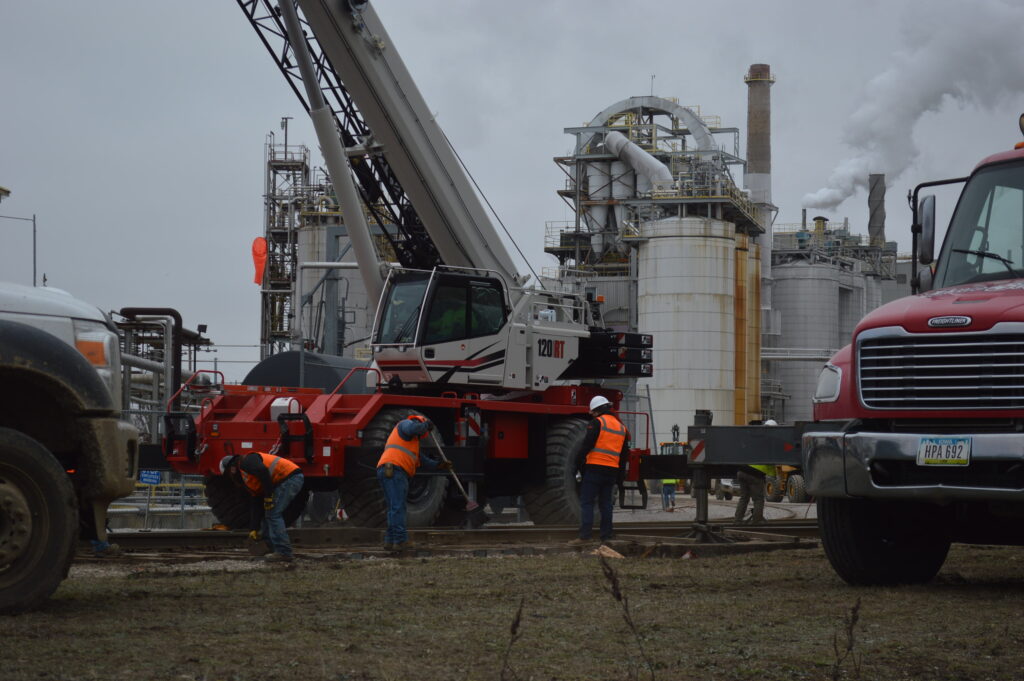
CEDAR RAPIDS, Iowa — A train derailment outside of the Cargill corn milling plant near Otis Road SE in Cedar Rapids has the neighborhood concerned.
Crews were still working on repairs at the site, next to 1710 16th St. SE, as of late afternoon Friday, Feb. 2.
According to Dan Pulis, facility manager for the Cedar Rapids Corn Milling Facility, a small section of the Union Pacific rail that runs adjacent to the facility was compromised, resulting in the derailment of an engine and three rail cars.
“There were no impacts to the engine/rail cars, people’s safety nor the environment,” a statement from Pulis said. “The engine and rail cars were moved to a viable section of the track. The compromised area of the rail is being repaired.”
Further questions regarding the time of the incident and other details were not answered Friday.
A public safety spokesman for Cedar Rapids police and fire departments said he was not made aware of the derailment.

Rail cars sit Feb. 2, 2024, in the Cargill railyard where pollinator plants once grew in Cedar Rapids, Iowa. (photo/Cindy Hadish)
While the derailment did not happen at Cargill’s new railyard, it raises red flags for neighbors, who fought for years against the industrial railyard that ultimately opened in December 2022, replacing a prairie pollinator zone.
Related: Neighbors worry Rompot will meet same fate as The Flats
Derailments were a major source of concern for the residents bordering Cargill’s new railyard adjacent to the Prairie Park Fishery.
“There are two railroad crossings between the processing plant and the storage yard,” Kerry Sanders, one of the neighbors who opposed the railyard said in an email. “Derailments have historically been a problem along this previously rarely used stretch of track. Blockage of either of those rail crossings would greatly increase response time to the neighborhood for emergency services, and would leave us trapped with no means of escape in the event of an internal emergency.”

Purple coneflower add color to the Prairie Pollinator Zone in southeast Cedar Rapids, before it was turned into an industrial rail yard for Cargill. (photo/Cindy Hadish)
Sanders added that converting the two rail crossings to silent crossings was a primary condition of the City Council allowing Cargill to construct their railyard facility.
“Two years after Cargill began using this full service rail processing facility, no work has begun on those silent crossings,” he wrote, saying the city has not prioritized the crossings. “Further bureaucratic delays have occurred, leading the residential community surrounding the rail yard to experience dozens of incidents a day of screeching rail horns, at a volume 3 or 4 times in excess of city code for noise offenses by members of the public.”
Sanders said repeated requests for information from the city have gone unanswered.
“The volume of those horn noises are in excess of a jet engine at 100’, and is capable of causing permanent hearing loss,” he wrote. “According to the World Health Organization, intermittent unexpected noises of that magnitude cause permanent learning disabilities in children, and lead to severe psychological trauma in adults.”
More: See “before” and “after” photos of the Prairie Pollinator Zone and more from the derailment, below:



[…] Story continues […]
[…] Story continues […]